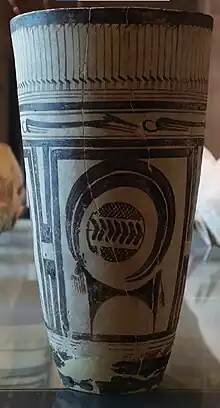| Bushel with ibex motifs | |
|---|---|
 | |
| Material | Terracotta |
| Height | 28.9 cm |
| Width | 16.4 cm |
| Created | c. 3,850 BC |
| Discovered | c. 1907 Shush, Khuzestan, Iran |
| Present location | Paris, Ile-de-France, France |
The bushel with ibex motifs, also known as the beaker with ibex motifs, is a prehistoric pottery artifact originating from Susa, an ancient city in the Near East located in modern-day Iran.[1][2] This piece of art is believed to have been created during the Susa I period, between 4200 and 3500 BCE.[1] The bushel is a large vessel, measuring 28.9 x 16.4 cm, and was used as a funerary item among the first inhabitants of Susa.[1][2][3]
The bushel is considered an example of animal style, a decorative approach in art that emphasizes animal motifs.[4] The bushel features various animal motifs including long-necked birds in the upper register, thought to be a kind of wading water bird commonly seen in the region's plains during winter.[5] The next register showcases reclining dogs, which are believed to be saluki or greyhound type hunting dogs typical of the area.[5]
The most notable feature of the bushel is the ibex, or mountain goat, motifs, located below the dogs.[5] The ibex, a native of the Zagros Mountain range near Susa, is portrayed in a non-naturalistic style using simple shapes such as triangles.[1][3] The goat's horns are depicted as arched back over its body, forming a circle.[5] The roundness of the horns and other geometric elements of the bushel are said to emphasize its cylindrical shape.[1]
The bushel was discovered during a 1906–1908 excavation of a Susian necropolis led by Jacques de Morgan.[1][6] It is now housed in the Louvre Museum in Paris, France, where it is recognized as a unique and well-crafted piece.[2][5]
References
- 1 2 3 4 5 6 Harris, Beth; Zucker, Steven (March 2, 2014). Bushel with ibex motifs. Khan Academy. Retrieved March 1, 2017.
- 1 2 3 "Vase". Louvre Collections. Louvre Museum. Retrieved 18 June 2023.
- 1 2 Annie, Caubet; Arnaud, Prévotat. "Bushel with ibex motifs". Louvre Museum. Retrieved March 1, 2017.
- ↑ Janson, Horst Woldemar; Janson, Anthony F. (2004). History of Art: The Western Tradition. Pearson Education. p. 85. ISBN 0-13-182623-9.
- 1 2 3 4 5 Harper, Prudence O.; Aruz, Joan; Tallon, Françoise (1992). The Royal City of Susa: Ancient Near Eastern Treasures in the Louvre. The Metropolitan Museum of Art, New York. pp. 32–33. ISBN 0-87099-651-7.
- ↑ Aruz, Joan; Wallenfels, Ronald (2003). Art of the First Cities: The Third Millennium B.C. from the Mediterranean to the Indus. The Metropolitan Museum of Art, New York. p. 352. ISBN 1-58839-043-8.